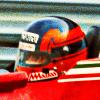I started this to not take up space on Barry's thread.
This is from the site Jim Thurman most graciously dug up for me at Track Forum.
Racewriter:
My '65 yearbook has some shots. If I get time this weekend, I'll see if I can get them scanned and posted somewhere. And speaking of that yearbook, I pulled it out this evening and now must correct myself.
The Peach Blossom 200 (miles) was held on October 11, 1964, and was promoted by American Raceways, Inc. Greg Weld was not the winner, but did win the pole at a tour of 157.434 MPH; the fastest IMCA sprint lap in history. It's entirely possible that this was the fastest average speed ever turned for a lap by anything classified as a "sprint car," anywhere. Leo Caldwell won in a Ford-powered upright in a field mixed with uprights and roadsters. Other top finishers:
2nd - Clare Lawicki
3rd - Curly Boyd
4th - Sam Sessions
5th - Red Amick
6th - John Logan
Average Speed - 124.998 MPH (probably also a record for a long sprint car race).
Caldwell won $4,125 of a total purse of $25,000; 28 cars started the race. Six of the year's 13 USAC National Championship races paid a lower purse, if that gives you an idea of the significance. Looking at the picture of the pace lap, the stands appear to be around half full. Remember that Atlanta struggled quite a bit in its first decade.
Talking to my dad, who was running some IMCA Stock races at the time, there was talk about IMCA returning to Atlanta in '65 with both Stock cars and Sprint cars, as the Peach Blossom 200 was universally considered a success at the time. It never happened. Instead, Atlanta went with USAC National Championship races in '65 and '66, then dropped open wheel entirely until the late 70s. As the USAC purses at Atlanta were more than double the PB200's, one wonders what might have happened had IMCA brought a doubleheader back in '65.
Carl - I have the Topeka Daily Capital clipping from the '49 race (I'm from Topeka), and interestingly enough, it refers to previous "IMCA Sanctioned Stock Car" races. For whatever reason, IMCA chose to reference that Topeka race as their first "official" New Model Stock Car race. Could have been a promotional dispute, as the use of the IMCA name was in some flux at the time.
He won the equivalent of, $34,648.40 in todays dollar value, which would be a large payout even today.
Purse was $209,990.32 which is huge by todays standards for a sprint car race..
Winner had a Ford which shows that this was still before Chevy dominated sprint car racing though in areas where sprints could run big blocks, Fords were not uncommon through into the seventies.
Big tracks and high speed half-mile tracks are disappearing so youths of the future will not know, first hand, just how challenging sprint car racing once was and why it led to Indy.















